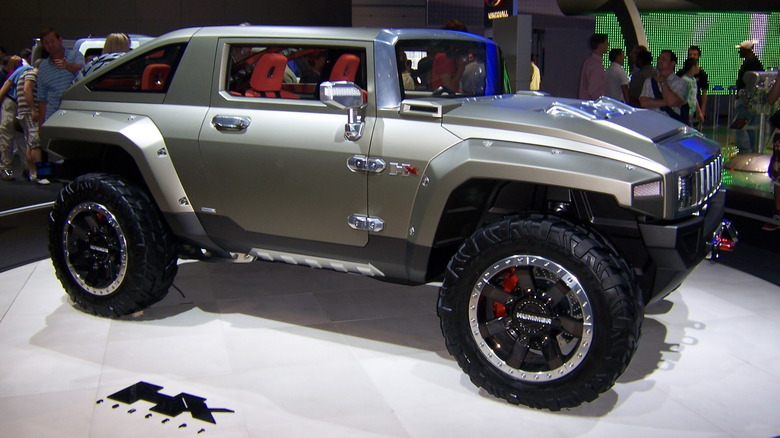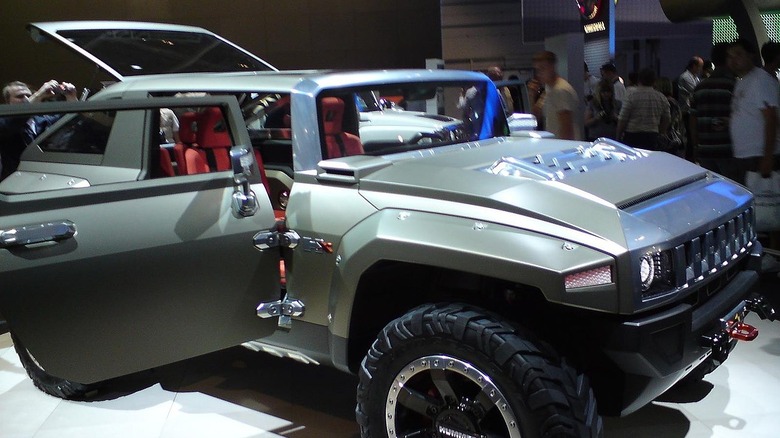The Forgotten Hummer Concept Car That Came Near The End Of The Brand's Popularity
When the first commercial Hummer hit the roads in 1992, it took America by storm. There wasn't another vehicle in the United States that epitomized "AMERICA!" more than the Hummer H1. It was based on the High Mobility Multipurpose Wheeled Vehicles (HMMWV, aka the Humvee) used by the military to move troops and cargo during wars (via History). It was quite literally a symbol for 'Murica — long before the memes ever existed.
It was also a diesel-guzzling beast that was frankly none too friendly to the environment (via ABC News). The Hummer's attention-grabbing looks drew the A-listers — from actors, to pop stars, to professional athletes — and became as much a focus for paparazzi as the celebs themselves (via Business Insider).
Then a coalescence of world events played out. The Iraq War had long been driving up gas prices, and then in 2007, "The Great Recession" hit (via Federal Reserve) and forced General Motors to declare bankruptcy in 2009 (via CNN). These things collided with the long-held notion that Hummers were nothing more than four-wheeled eco-terrorists, and GM decided to (along with other badges) end production of the Hummer H3 in May of 2010 (via MotorBiscuit).
The HX was not a humdrum Hummer
But before all that, in a last-ditch effort to keep the Hummer humming, GM dropped the Hummer HX concept at the 2008 North American International Auto Show (NAIAS) in Detroit (via Car and Driver). The big idea behind the HX was to make it smaller and give customer's the ability to personalize it as much as possible. It was meant to be GM's more upscale version of Jeep's Wrangler.
And it all came from the fresh young minds of three graduates (David Rojas, Min Young Kang, and Robert Jablonski) from Detroit's own College for Creative Studies, who GM had recently hired. Not surprisingly, they happened to be the very same "affluent young buyers" between 20 and 30 that GM was hoping to sell these SUVs to (via Car and Driver).
The overall 103-inch wheelbase was 10 inches shorter than the previous H3 model. It rode on massive 35-inch off-road tires, easy-to-clean rubber floors, and a gleaming aluminum instrument panel with configurable LCD instrument gauges wrapped in an interior that better resembled a flying machine from a video game than a four-seat 4x4 (per Driving Line). Each of the four bucket seats was equipped with a four-point restraint harness for extra protection and had a collapsible shovel, flashlight, and first-aid kit tucked away in them (via Car and Driver).
So many options!
The HX came with a 3.6-liter, direct-injection V-6 taken out of the Cadillac CTS — capable of producing 304 horsepower and 273 lb-ft of torque — that ran on biofuels (via Car and Driver).
But the show stopper of this Hummer was just how many pieces of the thing could be removed. For starters, if you felt like having an open-air vibe, the roof panel could be removed. If you wanted the doors off to taunt Wranglers, big chrome hinges allowed those to detach too. And, if you were out on a trail and damaged a fender, each one could also be popped off. Additionally, the "fastback" could be configured in three different ways. Remove the "slant" and keep the side rails for a "wagon" look, or remove those to make it more like a pickup (via Car and Driver). Options were plentiful.
It's very possible that the HX could have been the vehicle that saved GM from bankruptcy, or at least staunched the hemorrhaging Hummer line, but that's simply something we'll never know.

